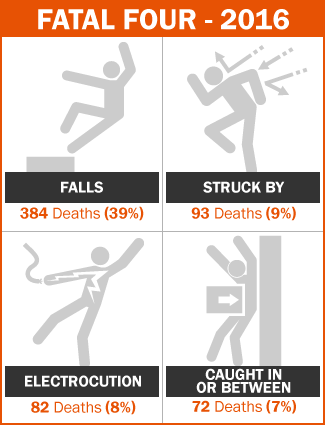OSHA Region 3 Kicks Up Construction Industry Hazard Awareness
03
February,
2023
2 MINUTE READ

From falls from scaffolding to being struck by large equipment, tragically there has been a steady number of fatalities in construction. To help spread awareness and improve injury numbers in construction, Occupational Health and Safety region 3 leader Nick DeJesse is rolling up his sleeves and hitting the pavement. DeJesse stands firm on the philosophy that every injury in construction is preventable. So, he's lined up training over the past month with a list of companies in several states.
Focus Four
OSHA and construction industry partners are rallying in a "Focus Four Hazards" campaign from now through June in OSHA region 3. Nearly 85% of construction work injuries stem from four principal hazards, called the "Fatal Four." These hazards were responsible for well over half (64%) of the construction worker deaths in 2016, according to the Bureau of Labor and Statistics.
 Falls: 384 out of 991 total deaths in construction in CY 2016 (39%)
Falls: 384 out of 991 total deaths in construction in CY 2016 (39%)- Caught In or Between: 72 (7%)
- Struck By: 93 (9%)
- Electrocution: 82 (8%)
Region 3's jurisdiction covers Pennsylvania, West Virginia, Virginia, Delaware, and Maryland, as well as Washington D.C. The campaign's goals are an ambitious push to raise awareness in the recognition, evaluation, and control of these hazards through the delivery of toolbox talks for employers to provide their workers. This is done through actively establishing relations with partnerships and alliances. By OSHA region 3 making themselves available, DeJesse said the department has seen an increase in invitations from a variety of companies to help expand on the safety dialogue.
DeJesse says getting everyone involved in the construction safety conversation "helps to add more synergy in the industry." "One of the goals is to raise the level of awareness of electrical hazards," he said. "Each month we cover one topic, provide statistics, identify hazards, and look for ways to eliminate and control them."
Expand Construction Safety Dialogue
Making toolbox talks more of a regular event results in a safe and healthy work site, DeJesse said. "The first 15 minutes of the day are vital," he said, speaking of construction industry talks that should occur each day. OSHA region 3 is stressing to companies and workers to develop a plan to routinely discuss safety training topics. This way, everyone is heard and valued. Along with open dialogue, DeJesse stressed the importance of having a prework inspection when assigning a task and for workers to evaluate the steps of that task while keeping in mind the proper safety controls. "Perform and review that job hazard analysis," he said. This includes following Lockout/Tagout (LO/TO), requiring workers to use the correct PPE, and providing safety oversight for dangerous work, like working in confined spaces. Remind workers about safety practices and communicate hazards throughout the worksite with safety signs and labels that can be seen and understood.
"We are the voice of the worker. We have to listen and think beyond compliance," DeJesse said.
RELATED RESOURCES

Improve Falling Objects, Struck-Bys in Construction
Falling objects and struck-bys are some of the most common job hazards that lead to injury or death in ...
Read
Safety Tips to Drive Down Work Traffic Injuries
The Drive Safely Work Week and Distracted Driving Awareness Month campaigns serve as reminders for workplaces ...
Read
Study: Training Lacks for Immigrant Workers
A recent study shows that immigrant workers at smaller construction firms are less likely to have safety ...
Read.png)


